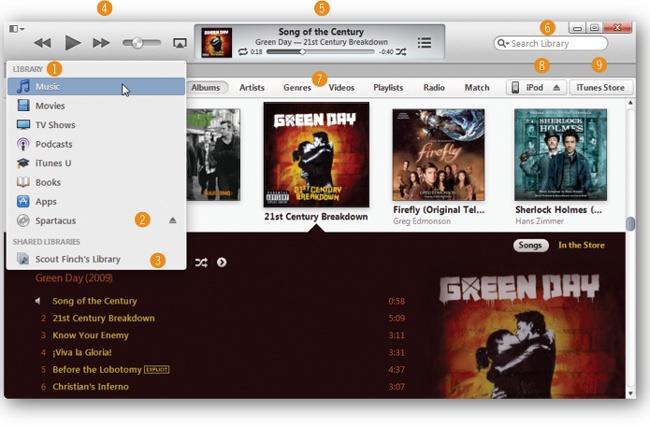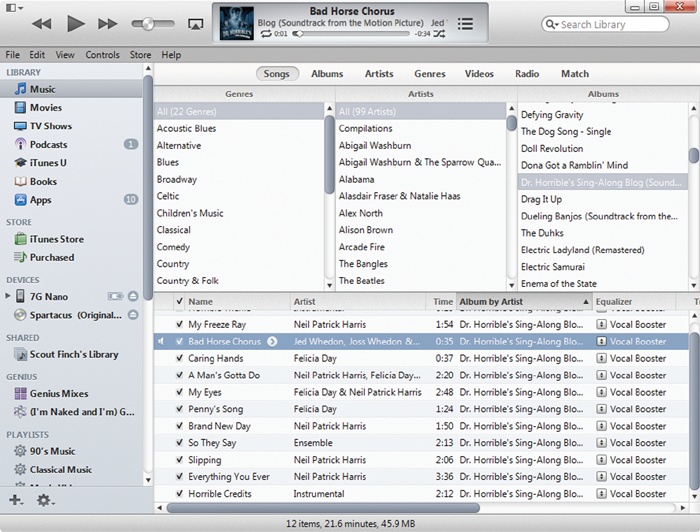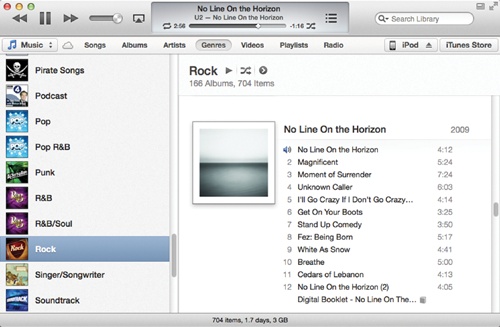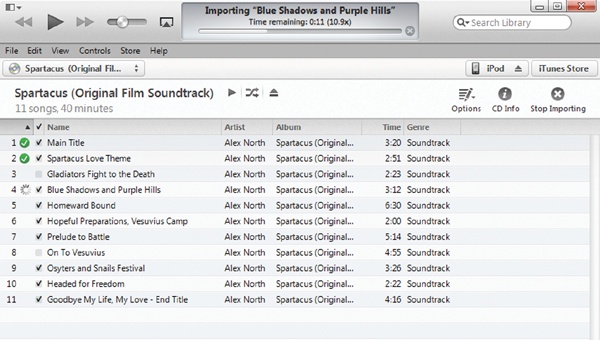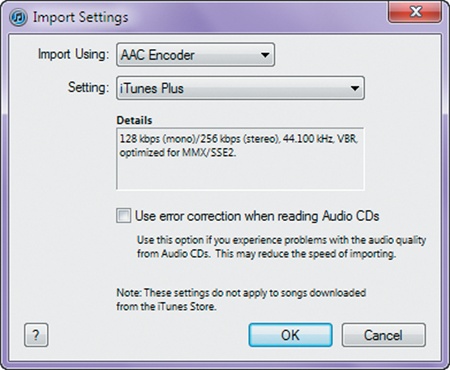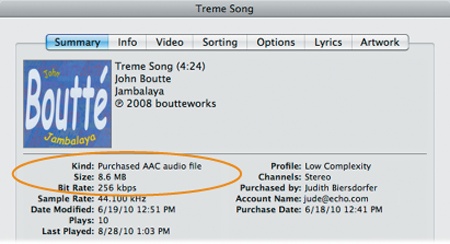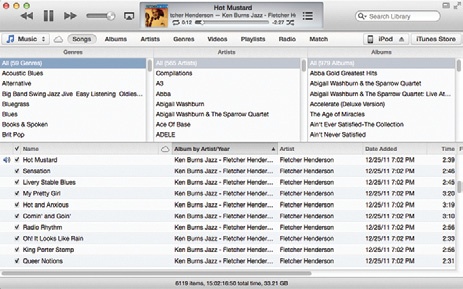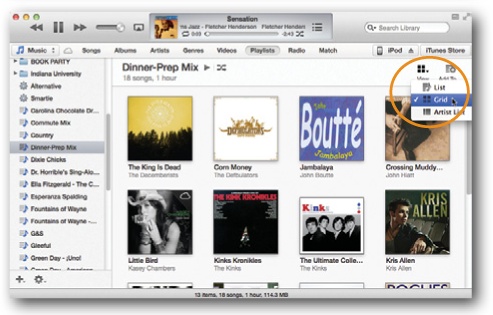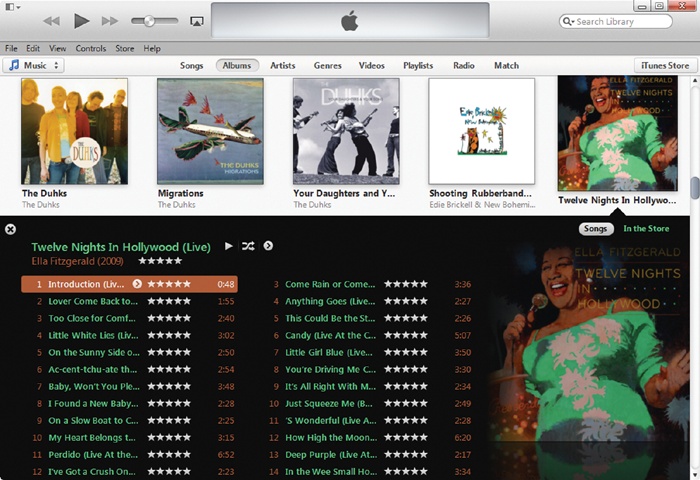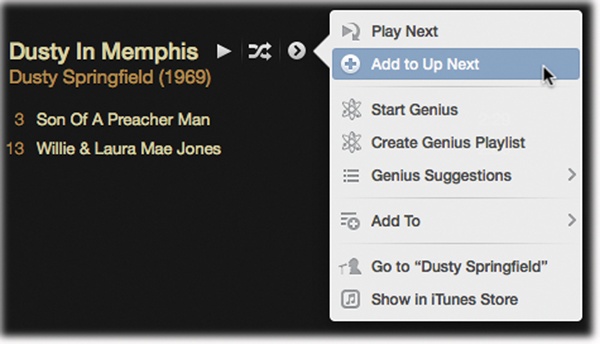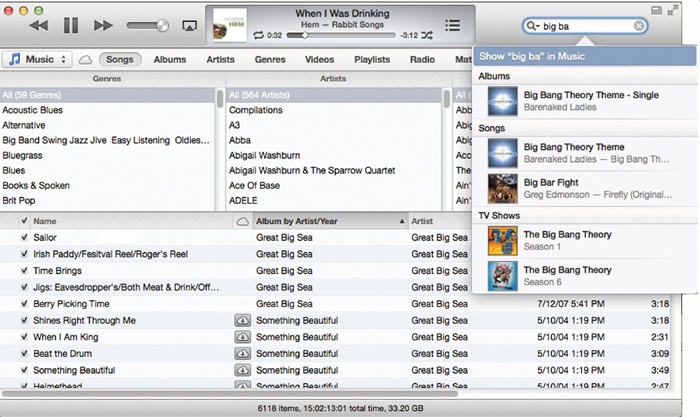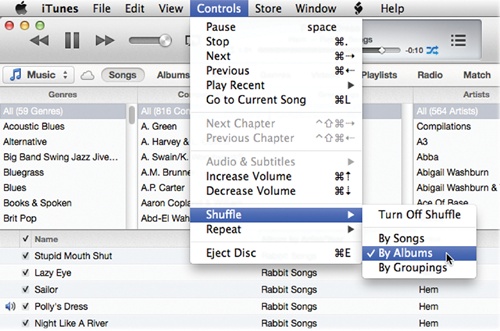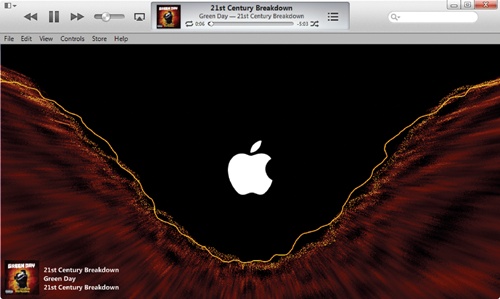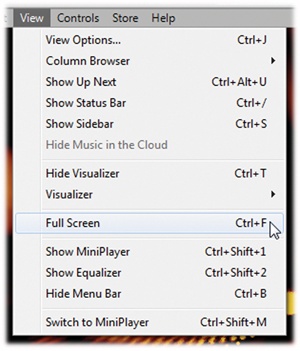Chapter 10. iTunes Basics
You’ll learn to:
Navigate the redesigned iTunes 11
Convert music from CDs
Customize iTunes’ look
Browse and search media
Shuffle your music
Relax with the Visualizer
IF YOU READ Chapter 1 to find a speedy way to get your iPod set up and ready to play, you’ve already dipped a toe into the iTunes waters. But as you may have guessed, beneath its pretty surface, iTunes is a deep well of media-management wonders.
Even if you haven’t bought any music from the iTunes Store yet, you can use the program to import music from your CD collection. Once you check everything into your iTunes library, the program makes it easy to browse and search through your media treasures. You can add song ratings, lyrics, and artwork to your music files, too.
Yes, iTunes is a powerful media organizer. So powerful, in fact, that this chapter focuses on its most basic and useful functions—like what its controls do and how to import music from CDs. Chapter 11 focuses on advanced iTunes features, and Chapter 12 tells you how to create customized song playlists. Chapter 13 is all about blowing your bucks at the iTunes Store, and Chapter 14 spotlights the video side of iTunes.
Even if you’ve used iTunes before, Apple overhauled the program in November 2012 to give a fresh look, new features, and a bit of zip under the hood. So turn the page to get to know iTunes 11 better.
The iTunes Window: An Introduction
ITUNES IS YOUR IPOD’S best friend. You can do just about everything with your digital files here—convert songs on a CD into iPod-ready tunes, buy music, listen to Internet radio stations, watch videos, and more. Here’s a quick tour of the main iTunes window and what all the buttons and sliders do.
The small drop-down menu on the left side of iTunes displays all your media libraries. Click an item in the panel to see its contents in the center of the main window, like so:
From the Library drop-down menu, you can see the types of media in your various libraries. As you add music, movies, and other stuff to iTunes, click the appropriate link to find what you’re looking for—songs, TV shows, and so on. Programs you buy for the iPod Touch land here under Apps. Want to change what iTunes lists? Press Ctrl+comma (⌘-comma) to call up iTunes’ Preferences menu, and then click the General tab. In the “Sources” area, turn on (or off) the checkboxes for, say, Tones or iTunes U.
If you have a music CD in your computer’s drive, it shows up in the Library menu as well. Click the gray Eject icon (
 ) next to the disc name to safely pop it out.
) next to the disc name to safely pop it out.In the Shared area, you can browse the media libraries of other iTunes fans and stream their music if you have iTunes’ Home Sharing feature turned on (Share Your iTunes Music and Videos). When you’re fully set up with Home Sharing, you can copy music and videos between machines.
The outer edges of the iTunes window are full of buttons and controls. Here’s what they do:
Play and pause a song or video—or jump to the next or previous track. The volume slider adjusts the sound level. If you see a
 icon, you have an Apple TV or set of AirPlay-enabled speakers on your network through which you can play your iTunes music (Chapter 12 has more on that). The Windows version of iTunes has a small square icon in the upper-left corner, as shown here. Click the triangle next to it to turn iTunes’ menu bar (File, Edit, View, and so on) on or off.
icon, you have an Apple TV or set of AirPlay-enabled speakers on your network through which you can play your iTunes music (Chapter 12 has more on that). The Windows version of iTunes has a small square icon in the upper-left corner, as shown here. Click the triangle next to it to turn iTunes’ menu bar (File, Edit, View, and so on) on or off.The center of the upper pane shows the song currently playing. Click the album cover to see a larger picture of it pop up on-screen, complete with its own set of playback controls (there’s an example on this chapter’s opening page). This window has a few other icons of note. Click the Loop icon (
 ) to repeat the current album or playlist and click it again so it looks like
) to repeat the current album or playlist and click it again so it looks like  to repeat the current track. Click the
to repeat the current track. Click the  icon to shuffle your music and click it again to return to normal song order. To see what’s in your Up Next list (Manage Your Expectations With Up Next), click
icon to shuffle your music and click it again to return to normal song order. To see what’s in your Up Next list (Manage Your Expectations With Up Next), click  .
.A search box awaits your keywords. Search iTunes has more on searching.
Next, there’s the horizontal row of buttons under the iTunes playback controls.
After you select a library from the drop-down menu on the left (Music, in this case), click any of the first four buttons to sort that library’s items into groups, like song titles, albums, and genres. Click Playlists to see all your customized song lists; Chapter 12 is all about those. Click the Radio button to stream any of the hundreds of Internet radio stations through iTunes, and click the Match button to see your iTunes Match collection (Use iTunes Match).
If your iPod is connected to iTunes, click the iPod button to sync new files, change the iPod’s settings, or see how much room you have left on it.
Feel a shopportunity coming on? Click the Store button to dive right into Apple’s online emporium, described in detail in Chapter 13. When you’re in the Store, this button changes to say Library—click it to go back home.
Change the Look of the iTunes Window
With iTunes 11, Apple radically overhauled the look of its all-purpose jukebox for the first time in nearly 10 years. For many people, it was a makeover long overdue. For newcomers to iTunes, well, they had to learn the program anyway. But for some long-time iTunes fans, the facelift was a jarring change that instantly lead to the question, “Hey, where’s all my stuff?
If you’re in that last group and long for the days of the Source panel that vertically listed all your libraries, connected devices, playlists, the iTunes Store, and everything else iTunes handled, fear not—Apple hasn’t abandoned you. With just a few quick trips to the View menu, you can get back to familiar territory:
To restore the Source list, that vertical pane along the left side of the window, choose View→Show Sidebar.
iTunes’ old multi-pane column browser in the Songs list sorted your music by genre, artist, album, composer, and grouping (the latter plays standalone but related tracks together—think movements in classical music). To restore it, click View→Column Browser→Show Column Browser and pick your options.
To see the information bar at the bottom of the iTunes window (the one that revealed the size of your iTunes library), choose View→Show Status Bar.
If you give iTunes 11 a retro look like the one described here, you can push and pull columns and panes by clicking their edges and dragging them with your mouse. You can also right-click (Control-click) any column header to add a category you can sort, or click and drag the columns into a new order.
Use the iTunes 11 MiniPlayer
LOVELY AS ITUNES IS, it takes up a heck of a lot of screen real estate. When you’re working on other things, you can shrink it down.
Full size. Here, iTunes shows you a lot of information about your media collection. This can be helpful when you’re making playlists (Chapter 12) or just poking around in different genres (shown below) for music that matches your mood. (You can even expand the playlist to full-screen view by clicking the standard “maximize” icon in the top-right corner of the Windows window, or the full-screen icon (
 ) in the top-right corner of the Mac version.)
) in the top-right corner of the Mac version.)MiniPlayer. It’s nice to see your collection so prominently, but if you’re just listening to music while working on a spreadsheet, you probably don’t need iTunes hogging up your screen. In that case, switch to the MiniPlayer by pressing Ctrl+M (Shift-⌘-M) or by choosing View→Switch to MiniPlayer. The MiniPlayer displays the name of the current track—until you pass the mouse cursor over it and then it switches to playback controls (below).
Tired of losing your iTunes mini-player among an array of windows on your screen? Make it always visible, so that it sits on top of other open windows, documents, and assorted screen detritus. Open iTunes Preferences (Ctrl+comma [⌘-comma]), click the Advanced tab, and then turn on the checkbox next to “Keep Mini Player on top of all other windows.” Now you won’t have to click frantically around the screen trying to find iTunes if you get caught listening to your bubblegum-pop playlist at work.
Import Selected Songs from Your CDs
IN Chapter 1, YOU learned how iTunes simplifies converting (also called ripping) songs from your compact discs into small, iPod-ready digital files: Pop a CD into your computer’s disc drive and iTunes walks you through the process. If you’re connected to the Internet, iTunes downloads song titles and other album info. A few minutes later, you’ve got copies of those songs in iTunes.
If you need time to think about which songs you want from a CD, no problem. Summon the Preferences box (Ctrl+comma [⌘-comma]), click the General tab, and then change the menu next to “When you insert a CD” to “Show CD.”
So now, if you don’t want to rip an entire album—you may not want anything from Don McLean’s American Pie besides the title track, for example—you can exclude songs you don’t want by removing the checkmarks next to their names. Once you pick your songs, click the Import CD button in the bottom-right corner of the screen.
Tip
If you know you want all the songs on that stack of CDs next to your computer, just change the iTunes CD import preferences to “Import CD and Eject” to save yourself some clicking.
You can Ctrl+click (⌘-click) any box to deselect all the checkboxes at once. To turn them all on again, Ctrl+click (⌘-click) a box next to an unchecked song. This is a great technique when you want only one or two songs from a CD; turn off all the checkboxes, and then turn on only the tracks you want.
As the import process starts, iTunes moves down the list of checked songs, converting each one to a file and, in Windows 7/8, dropping it in your Music→iTunes→iTunes Media→Music folder. On Mac OS X systems, songs go in the Home→Music→iTunes→iTunes Media→Music folder. (If you’ve had iTunes for years, your iTunes Media folder is probably still called iTunes Music, and there’s a separate Music folder inside it.)
An ![]() icon next to a song name means that iTunes is currently converting the track. Feel free to switch to other programs, answer email, surf the Web, or do any other work as iTunes rips away. If you skipped the chance to download song titles when you inserted the disc, click the Options icon on the right side of window to get them manually. Click the CD Info button to see the disc’s name and title. If you decide to abandon your mission, click the Stop Importing icon.
icon next to a song name means that iTunes is currently converting the track. Feel free to switch to other programs, answer email, surf the Web, or do any other work as iTunes rips away. If you skipped the chance to download song titles when you inserted the disc, click the Options icon on the right side of window to get them manually. Click the CD Info button to see the disc’s name and title. If you decide to abandon your mission, click the Stop Importing icon.
Once iTunes finishes ripping, each imported song bears a green checkmark, and the program signals its success with a melodious little flourish. Now you have some brand-new songs in your iTunes music library.
Tip
Don’t like all those checkboxes next to song titles cluttering up your screen? Turn them off in the Preferences box shown on the opposite page. Press Ctrl+comma [⌘-comma] to get the box, and then click the General tab. Turn off the checkbox next to “Show list checkboxes” (ironic, huh?). If you want an all-over streamlined look, turn off the little icons next to Source-list items by turning off the checkbox next to “Show source icons.”
Change Import Settings for Better Audio Quality
IF YOU’RE HAPPY WITH the way your music sounds on your iPod or through a pair of external speakers, feel free to safely ignore this page. But If you find the audio quality lacking, you can change the way iTunes encodes, or converts, songs when it imports them from a CD.
iPods can play several digital audio formats: AAC, MP3, WAV, AIFF, and one called Apple Lossless. In iTunes’ Import Settings box (Edit [iTunes]→ Preferences→General, and then click Import Settings), you get two main options. They are:
Audio format (use the drop-down menu beside “Import Using”). Some formats tightly compress audio to save space. The trade-off: lost sound quality. Highly compressed formats include AAC (iTunes’ default setting) and MP3. Formats that use little or no compression include WAV and AIFF; they sound better, but they take up more space. Apple Lossless splits the difference: better sound quality than AAC and MP3, but not as hefty as WAV or AIFF.
Bit rate (beside “Setting”). The higher the number of bits listed, the greater the amount of data the file contains, and the larger the file size. The advantage? Better sound quality.
To see a song’s format and other technical info, click its title in iTunes, press Ctrl+I (⌘-I), and then click the Summary tab in the Get Info box. (See your name and Apple ID listed on iTunes Store tracks? Apple does keep a record of these things.)
Ways to Browse Your Collection
INSTEAD OF JUST PRESENTING you with boring lists, iTunes gives you multiple ways to browse your media collection, some more visual than others. Just click the appropriate button at the top of the iTunes window. In all the views, an unadorned cloud or a ![]() icon next to a title means you bought the item on another device and can download it here from iCloud (Set Up an iCloud Account).
icon next to a title means you bought the item on another device and can download it here from iCloud (Set Up an iCloud Account).
List View. The all-text display (shown top right) is favored by people who use screen-reader software or find comfort in the layout of Excel spreadsheets. Clicking the Songs button automatically puts you in List view, but you can make List an option for other media by pressing Ctrl+comma in Windows or ⌘-comma on a Mac. That opens the Preferences box. Click the General tab and turn on the checkbox next to “Show list views for all media.”
Playlist View Options. After you click the Playlists button, you may want to see your custom compilations displayed as a grid of album covers or sorted by artist. Click the View icon in the Playlist window (circled, middle right) and choose a new look for your list.
Artist View. Click Artists in the iTunes window to see all the bands and singers in your collection listed alphabetically along the left (shown bottom above). Click a band’s name, and then click the Songs button in the middle of the window (circled) to see all the tracks you own by that band. Click the Gallery button to see online photos of the band, and click the “In the Store” button to see other albums by that artist.
Album view. To see your music collection displayed as a striking collection of interactive album covers…turn the page.
Album View in iTunes 11
IN PREVIOUS VERSIONS OF iTunes, the Album view was a fairly straightforward affair—you got to see your music collection displayed as rows of colorful jacket art. (Unless, of course, you ripped the tracks from your own CDs and didn’t manually add your own artwork—you then see a gray music note, but the next chapter tells you how to fix that.)
iTunes 11 takes the traditional Album view and makes it much more useful. To see for yourself, click the Albums button at the top of the iTunes window. Now, click an album cover.
As shown here, the middle of the iTunes window opens up to reveal all the tracks on that album. You also see the ratings you gave them (Chapter 11) and the running time for each song. If you want more from a particular artist, click “In the Store” on the right side of the screen, and Apple shows you everything else by that singer or band. And it will gladly sell you their wares.
The open Album view also gives you a play button (![]() ), a shuffle button (
), a shuffle button (![]() ), and the
), and the ![]() menu icon. Click the latter to get menu options for adding the album to your Up Next list, creating a Genius playlist, or adding the album to a playlist (you’ll find all these options explained in Chapter 12).
menu icon. Click the latter to get menu options for adding the album to your Up Next list, creating a Genius playlist, or adding the album to a playlist (you’ll find all these options explained in Chapter 12).
Search iTunes
AS YOUR ITUNES MEDIA library grows, you may have trouble remembering just what songs, movies, and so on you have, or what album a song came from. In times like these, take to the trusty search box in the right-hand corner of the iTunes window.
As with search boxes on Web browsers, operating systems, and every place else they tend to appear, you just have to start typing in a keyword (the artist’s name, a song title, and so on). With each letter you type, iTunes shortens the list it displays, showing you only titles that match what you type.
For example, typing train brings up a list of everything in your collection that has the word “train” somewhere in the song’s information—maybe in the song’s title (“Mystery Train”), the band name (Wire Train), or the album name (Train A Comin’). The search function in iTunes 11 doesn’t limit itself to just one type of media, either. As shown below, you get results from across your media empire. Click a result in the list to jump to that item.
Another way to search for specific items is to use Songs/List view and the Column Browser mentioned earlier in this chapter. (If you can’t see the column browser, press Ctrl+B [⌘-B].)
Depending on how you configured the browser in View→Column Browser, it reveals your music collection grouped by genre, artist, album, composer, or grouping—all in a nice vertical list. Hit the same keys again (Ctrl+B [⌘-B]) to close the browser.
Shuffle Your Music in Many Ways
WITH ITS ABILITY TO randomly pluck and play songs, iTunes’ Shuffle feature has a huge number of fans, especially those who don’t want to think about what to listen to as they noodle around the Internet. To start shuffling, click ![]() at the top of the iTunes window; the icon turns blue when the player is set to shuffle. As you may remember from a couple of pages ago, you see this same icon in Album view when you have an album selected.
at the top of the iTunes window; the icon turns blue when the player is set to shuffle. As you may remember from a couple of pages ago, you see this same icon in Album view when you have an album selected.
You’re not stuck with a single shuffling method, either. Some days you may feel like mixing up your music song by song, and other days you may be in the mood to change things up by album.
To control just what iTunes shuffles, choose Controls→Shuffle and select Songs, Albums, or Groupings from the submenu. (“Grouping” is a way to keep certain tracks together in your iTunes library, like separate movements in a piece of classical music that are part of a larger work.)
Animate Your Songs: iTunes Visualizer
VISUALIZER IS THE ITUNES term for an on-screen laser-light show that pulses, beats, and dances in perfect sync to your music. The effect is hypnotic and wild, especially when summoned midway through a sluggish day at the office.
You need to pick a set of animations first. Choose View→Visualizer to select from the iTunes Visualizer (lots of Disco in Space moments) or the iTunes Classic Visualizer (trippy psychedelic patterns-a-go-go, as shown below).
To summon the scenery, choose View→Show Visualizer. The show begins immediately. To see a tiny menu of even more controls for either Visualizer, press the / key and then the letter of the desired command listed on-screen. It’s a great way to fiddle.
If you find the iTunes window too constraining for all this eye candy, play it full-screen by going to View→Full Screen (View→Enter Full Screen). The keyboard shortcut for this coast-to-coast visual goodness is Ctrl+F (Ctrl-⌘-F).
True, you won’t get a lot of work done, but when it comes to stress relief, visuals are a lot cheaper than a hot tub.


